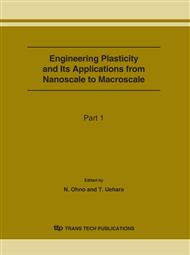p.489
p.495
p.501
p.507
p.513
p.519
p.525
p.531
p.537
Characteristics of Complementary Plastic Energy Produced by Hysteresis Curves and Analyses of Microstructures in Fatigued Metals
Abstract:
Experimental characteristics of complementary plastic energy produced by a stress-strain hysteresis curve at a saturated stage in low cycle fatigue are investigated for some steels, and mechanical models for analyzing microstructures of fatigued metals are discussed. As a result, it is found that volume of a cell is varied in inverse proportion to plastic strain range: the density of cells is in proportion to plastic strain range. Consequently, the total number of cells is proportional to plastic strain range. This final conclusion is similar to Winter's opinion concerning persistent slip band structures in high cycle fatigue [1] where, although wall spacing of a cell is invariable and inde-pendent of plastic strain range, a region occupied by persistent slip bands increases proportionally to plastic strain range and consequently the number of cells is in proportion to plastic strain range.
Info:
Periodical:
Pages:
513-518
Citation:
Online since:
June 2007
Authors:
Price:
Сopyright:
© 2007 Trans Tech Publications Ltd. All Rights Reserved
Share:
Citation:


